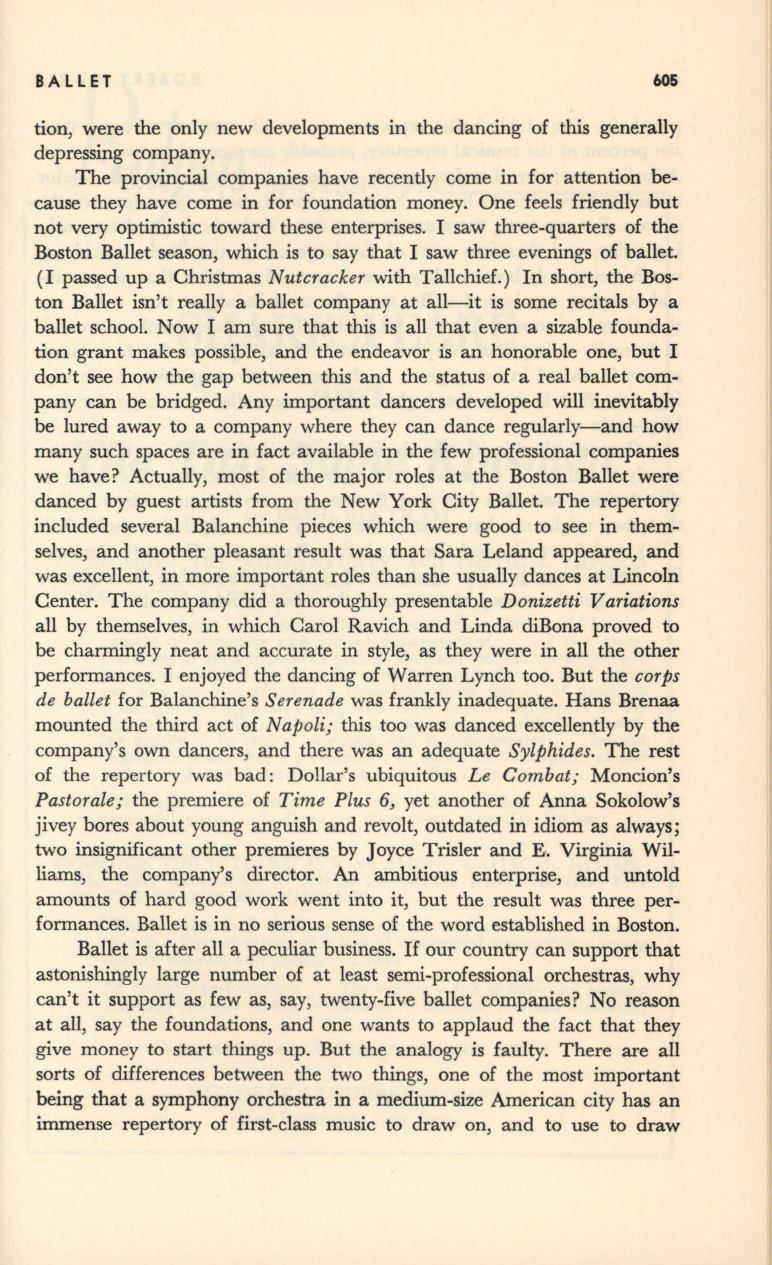
BALLET
605
tion, were the only new developments in the dancing of this generally
depressing company.
The provincial companies have recently come in for attention be–
cause they have come in for foundation money. One feels friendly but
not very optimistic toward these enterprises. I saw three-quarters of the
Boston Ballet season, which is to say that I saw three evenings of ballet.
(I passed up a Christmas
Nutcracker
with Tallchief.) In short, the Bos–
ton Ballet isn't really a ballet company at all-it is some recitals by a
ballet school. Now I am sure that this is all that even a sizable founda–
tion grant makes possible, and the endeavor is an honorable one, but I
don't see how the gap between this and the status of a real ballet com–
pany can be bridged. Any important dancers developed will inevitably
be lured away to a company where they can dance regularly-and how
many such spaces are in fact available
in
the few professional companies
we have? Actually, most of the major roles at the Boston Ballet were
danced by guest artists from the New York City Ballet. The repertory
included several Balanchine pieces which were good to see in them–
selves, and another pleasant result was that Sara Leland appeared, and
was excellent, in more important roles than she usually dances at Lincoln
Center. The company did a thoroughly presentable
Donizetti Variations
all by themselves, in which Carol Ravich and Linda diBona proved to
be charmingly neat and accurate in style, as they were in all the other
performances. I enjoyed the dancing of Warren Lynch too. But the
corps
de ballet
for Balanchine's
Serenade
was frankly inadequate. Hans Brenaa
mounted the third act of
Napoli;
this too was danced excellently by the
company's own dancers, and there was an adequate
Sylphides.
The rest
of the repertory was bad: Dollar's ubiquitous
Le Combat;
Moncion's
Pastorale;
the premiere of
Time Plus
6, yet another of Anna Sokolow's
jivey bores about young anguish and revolt, outdated in idiom as always;
two insignificant other premieres by Joyce Trisler and E. Virginia Wil–
liams, the company's director. An ambitious enterprise, and untold
amounts of hard good work went into it, but the result was three per–
formances. Ballet is in no serious sense of the word established in Boston.
Ballet is after all a peculiar business.
If
our country can support that
astonishingly large number of at least semi-professional orchestras, why
can't it support as few as, say, twenty-five ballet companies? No reason
at all, say the foundations, and one wants to applaud the fact that they
give money to start things up. But the analogy is faulty. There are all
sorts of differences between the two things, one of the most important
being that a symphony orchestra in a medium-size American city has an
immense repertory of first-class music to draw on, and to use to draw


